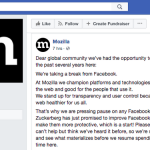Facebook’s ad placement reports were supposed to roll out to all advertisers last year but have not
To address advertisers’ transparency concerns, last year Facebook said it would provide all advertisers with reports of where their ads could and did appear. But many brands are still waiting for access.

Last year, Facebook said it would provide all advertisers with reports listing the publishers on whose sites, apps, Instant Articles and native Facebook videos their ads may appear when buying that inventory from the social network. But those reports have not yet become widely available.
Facebook has been gradually rolling out the pre-campaign placement lists that were announced in June 2017 and expects to make them available to all managed advertisers by the end of Q1 2018, according to a company spokesperson. Facebook does not currently have a timeline for when the lists will become available to all of its more than 6 million advertisers, including those buying ads through its self-serve ad-buying tools, the spokesperson said.
According to the spokesperson, Facebook is reviewing the lists to make sure they accurately account for the publishers in its monetization programs before making them widely available.
Pre-placement reports
To date Facebook’s managed advertisers have received reports for some of the potential placements that Facebook said it would provide them before they place an ad buy. Those include in-stream placements — or, when a brand’s video ad is attached to a publisher’s native Facebook video as a pre-roll or mid-roll ad — and rewarded video placements across Facebook’s Audience Network ad network. And earlier this week, Facebook began reporting potential placements for the rest of its Audience Network inventory, leaving its Instant Articles inventory as the remaining placement to be provided.
Post-placement reports
Facebook also has not fully rolled out the post-campaign placement reports, which it said in September 2017 it would provide advertisers, listing where their ads did in fact appear. Those reports have begun to roll out, and Facebook expects them to be available to all managed advertisers by the middle of this year, the spokesperson said.
Transparency concerns
The delay of the pre- and post-campaign placement reports could be a setback for Facebook as it maxes out the number of ads it can squeeze into people’s News Feeds and looks to native videos, Instant Articles and Audience Network as something of a release valve.
Unlike with ads within Facebook’s News Feed, advertisers can be hesitant to let their ads appear within an undisclosed publisher’s video or article or on its site because they cannot be sure of the context in which their ad appears and whether it is considered suitable for their brand. Facebook’s lack of transparency on the issue has led major ad buyers, such as WPP’s GroupM and Publicis Groupe’s DigitasLBi, to advise their clients against buying Facebook’s Audience Network inventory.
Advertisers’ concerns with where their ads appear may become further inflamed as more attention is driven to the types of publishers in Facebook’s monetization programs. Earlier this week, BuzzFeed reported on two dozen fake-news publishers that had published Instant Articles featuring ads bought through Facebook’s ad network.
Facebook’s pre- and post-campaign placement reports were supposed to address these transparency concerns and, in combination with Facebook’s blocklists, enable advertisers to avoid any unwanted inventory. And they just may, but only once advertisers can access them.
Marketing Land – Internet Marketing News, Strategies & Tips
(29)












